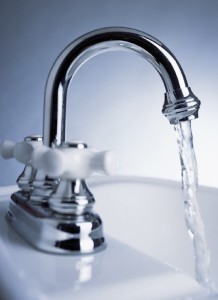Water Conservation
Conserve water and save money by using high-efficiency low-flow faucet, shower heads and toilets.
Conserve water and save money by using high-efficiency low-flow faucet, shower heads and toilets.
In previous articles we have shown that fixing leaky toilets or leaky faucets are easy ways to conserve water and lower water bills. If you don’t have water leaks or have already fixed them, there are other simple and inexpensive water conservation tips you can use to save money. Studies show that of the indoor water use, 41% is use for flushing toilets and 33% is used for washing. By focusing on the bathroom which is the area that consumes the most water, you can effectively and quickly reduce water consumption and lower your water bill. If you can reduce water consumption by 1000 gallons per month, you can save on average about $140 a year on your water bill. Each of the following water conservation tips will help you achieve this goal.
 Standard kitchen and bathroom faucets use between 4 and 7 gallons of water per minute, much of that water flows right down drain. If your existing faucet flows more than 3 gallons per minute, installing a low-flow faucet aerator is a good way to conserve water. You can measure the current faucet flow rate by placing an empty one gallon milk jug under the faucet, and time how many seconds it takes to fill the jug under normal water pressure. If it takes 20 seconds or less, you should use a faucet aerator. Faucet aerators replace the faucet head screens, lowering the flow by adding air to the water spray. A faucet aerator also reduces splashing and increases coverage area, therefore conserves water and improve the faucet performance. For a bathroom faucet, a 1.0 to 1.5 gallon-per-minute aerator will be sufficient for your hygiene needs. Kitchen faucets need a 2.2 to 2.5 gallon-per-minute aerator for dish washing needs. Tap water use can be reduced up to 50% simply by using low-flow faucet aerators saving 1100 to 1500 gallons of water per month. A faucet aerator usually costs $5 to $10 and requires minimal effort to install.
Standard kitchen and bathroom faucets use between 4 and 7 gallons of water per minute, much of that water flows right down drain. If your existing faucet flows more than 3 gallons per minute, installing a low-flow faucet aerator is a good way to conserve water. You can measure the current faucet flow rate by placing an empty one gallon milk jug under the faucet, and time how many seconds it takes to fill the jug under normal water pressure. If it takes 20 seconds or less, you should use a faucet aerator. Faucet aerators replace the faucet head screens, lowering the flow by adding air to the water spray. A faucet aerator also reduces splashing and increases coverage area, therefore conserves water and improve the faucet performance. For a bathroom faucet, a 1.0 to 1.5 gallon-per-minute aerator will be sufficient for your hygiene needs. Kitchen faucets need a 2.2 to 2.5 gallon-per-minute aerator for dish washing needs. Tap water use can be reduced up to 50% simply by using low-flow faucet aerators saving 1100 to 1500 gallons of water per month. A faucet aerator usually costs $5 to $10 and requires minimal effort to install.
Find Low Flow Faucet Aerators on Amazon.com
Standard shower heads distribute around 5 to 8 gallons of water per minute, consuming 40 gallons of water for a five-minute shower. To determine your shower head’s flow rate, you can place a bucket marked in single gallon increments under your shower head and time how many seconds it takes to fill 1 gallon. If it takes less than 20 seconds, you should replace it with a low-flow shower head. Typically, a new low-flow shower head distributes 2.5 gallons of water per minute, cutting your five-minute shower usage from 40 to 12.5 gallons of water. Ultra low-flow shower heads only use from 0.8 to 1.5 gallons of water per minute and reduce your average usage to 7.5 gallons per shower. If you limit the shower time to 5 minutes and use efficient low-flow shower heads, you can reduce your shower water usage by 50% saving up to 1100 gallons of water per month. A low-flow shower head cost from $8 to $50 and can pay for itself very quickly by lowering water bills.
Find Low Flow Showerheads on Amazon.com
A low-flush toilet uses significantly less water than a full-flush toilet. Most low-flush toilets use 1.6 gallons per flush while full-flush toilets use 3.5 gallons per flush. You can save up to 1300 gallons of water per month by replacing the older toilets with new eco-friendly ones. From 2002, all new toilets have been redesigned to conserve water by only using 1.6 gallon per flush. If you still have the older toilets manufactured before 2002, it’s better to replace it with the new one. An alternative choice is to install a toilet retrofit device for an older toilet or a toilet tank dam which can cut your toilet water use by 30% and save 270 gallons of water per month.
Each of the above water conservation tips can save you more than 1000 gallons of water per month, giving you the ability to save $140 per year in your water bill. By implementing two or more water conservation tips, you can double or triple the savings. Furthermore, you can reduce water heating costs, which can save money on your electric or gas bills. For us, it was a success story. After fixing toilet leaks and implementing these water conservation tips, we have cut our water usage by 11 hundred cubic feet (CCF) or 8228 gallons over the past two months and instead of having to pay, we received a credit of $104.70 on our last water bill. Do it for the planet or do it for your wallet, regardless of the reason conserving water is just smart.